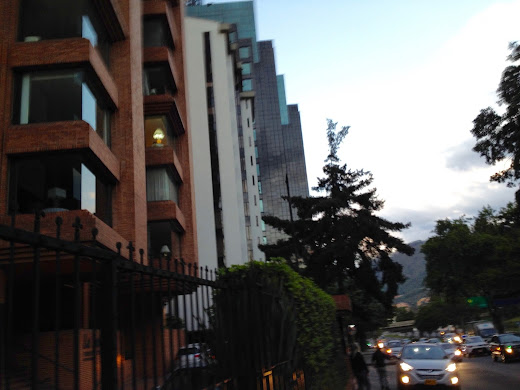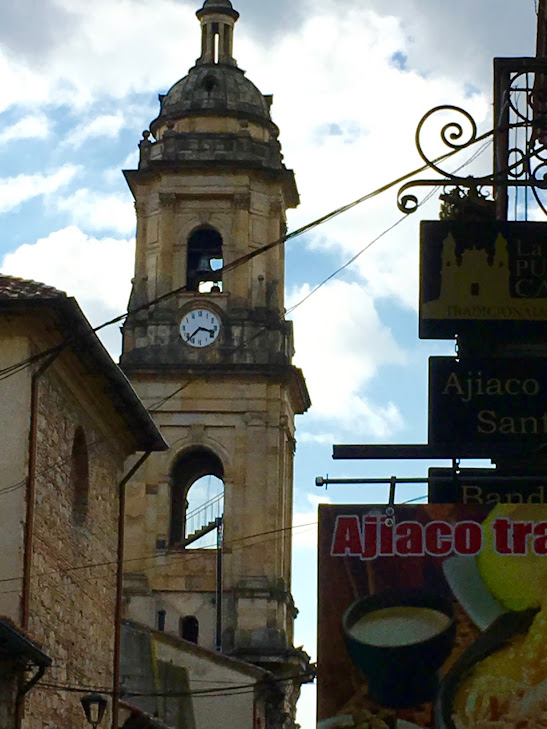(Drivebycuriosity) - After visiting Cartagena (here my report) and Medellín ( impressions) we traveled to Bogota, where we stayed 5 nights. The Colombian capital is a cosmopolitan vibrant city with a population of about 8 million people, comparable to New York City. But Bogota resembles more Los Angeles. The city is a patchwork of towns which sprawl over a vast valley between the mountain chains of the Andes and stretches over 600 square miles (1,5 sq km) (Los Angeles covers 500 square miles (1,300 km2).
Bogota is a fascinating emerging markets center. Ther per-capital income is below the (low) average of Latin America but above the Colombian average (typical for big cities colombiareports ). The city is the financial center (about 40% of its income), the site of the Colombian stock exchange and collects a lot company headquarters (petrol, cement, finance, utilities etc).
Bogota is a city of sharp contrasts. We saw a medley of very different parts; very modern & wealthy areas are mixed with traditional low income districts. Bogota has a strong north-south divide and seems so to represent the global economy. In the north, especially on the slopes of the eastern mountains, you can see oases of wealth, when you go to the city center and more southwards the environment gets poorer. Anyway, Bogota is part of the global technology community, all over the city you can find spots where we could get free Wi-Fi, even in the traditional city center.
Some parts of the metropolis display an accumulation of wealth that you usually can find in New York City or in Washington DC and look like Manhattan`s Financial District or the elitist Upper West Side.
Above some of the elegant streets which could be in San Francisco or the wealthy parts of Washington DC.
I was impressed by the modern architecture. Many districts - and local city centers - looked pretty new, maybe they got build in the recent 20 years, but we didn´t see much construction. It seems there had been a construction boom in the recent years which has ebbed up, maybe a response to the global recession in the year 2008 and the sluggish recovery of the global economy since then.
Two Different Countries?
We were hiking a lot - up to 140 blocks a day - and explored also parts of the traditional districts which dominate the center and the south. It look like that these part belong to a different country.
Bogota`s climate is bizarre thanks to an elevation of 2,640 m (8,660 ft). The thin air delivers little protection against the almost equatorial sunshine and causes sharp temperature swings. At lunch time we got burned by a torching sun, but we didn´t feel it because the thermometer crawled hardly above 60F/ 15 C . At around 4 pm the temperature started to fall and dropped after sun set (around 6 pm) below 50F/10 C.
The intense sunlight delivered flamboyant images and special impressions. But it also made photographing more challenging. The thin atmosphere creates sharp contrasts between the sunny parts and the shades. Often the camera (iPhone 6 plus) adapted to the bright light and the shady parts got very dark.
Botoga has a bad reputation thanks to the violent history and the bloody civil war which had tormented the country for decades. But this is history. Last year Colombia`s president Juan Manuel Santos got the Nobel Peace Price for ending the 50-year conflict with the leftist rebel group Revolutionary Armed Forces of Colombia. It seems he is doing a very good job. Today Colombia`s capital is not more unsafe than New York City and other metropolis of the world. This safety is enforced by a massive police presence. You can see cops everywhere. While we were attending a 3-hours guided walking tour through the traditional center of the city we got escorted by one police officer.
Run For Your Life
But Bogota has a still big problem - the traffic. The huge city does have no subway or a similar train system. The population - and the millions who are commuting daily for working, shopping & leisure - have to use buses, cars & motorbikes. As a result the streets are often clocked and a taxi drive from our hotel to the city center - about 100 blocks - needs one hour. Unfortunately the Colombians drive aggressively, especially the ubiquitous motorbikers, who accelerate when the traffic light turns green. Both, car drivers & bikers, squeeze into any available space to advance in the frequent traffic jams.
Pedestrian have to run for their lives when they cross the streets. Traffic lights don´t help much. The green phases for pedestrians are to short to cross the whole street - and then they have to escape the attack of the motorbikers - toreros on 2 wheels. Even more dangerous are the speedy left- and -right-turning vehicles who seem to hunt the poor pedestrians.
Using a taxi is another challenge. Taxi drivers don´t understand English, like the rest of the population, and they didn`t know our locations, including the hotel. The city is huge, but the streets follow a grit system, a chess board pattern, like Manhattan. Carreras (streets) run from South to North, the calles (also streets) cross the Carreras and run from East to West. Apparently not much help for the taxi drivers. Showing them the address in print, doesn`t help either. It looked like that many have problems to read. Nor did it help to show them the location on Google map. But finally they managed to bring us to our locations.
But Bogota offers some comforts: The city has a lot of lush parks and other beautiful green spots. It seems that the vegetation benefits from the intense sun light and the fact that frosts are very rare.
During our hikes and taxi rides we spotted a lot of street art which add to the fascination of the city.
Bogota was an interesting experience. Maybe some day we will come back.






















































No comments:
Post a Comment